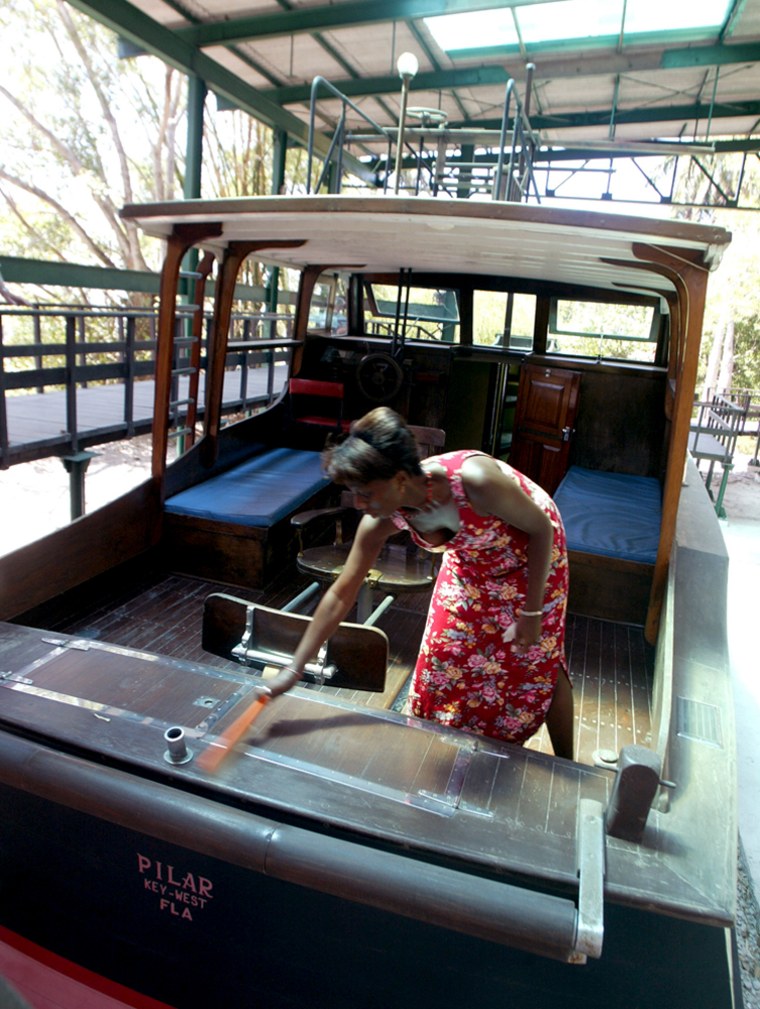Tropical fruit trees and trim gardens greet visitors to Ernest Hemingway’s sprawling estate on the outskirts of Havana, but the wooden home where he lived for more than 20 years is falling apart — hit by erosion, tropical humidity and botched repairs.
But American preservationists riding to the rescue have run up against the politics dividing the U.S. and Cuban governments.
The Bush administration has taken a tough stance on the communist-run island, tightening long-standing trade and travel restrictions. The result: The preservationists were denied a license to travel to Cuba last year.
But the Hemingway Preservation Foundation in Concord, Mass., joined forces with the Washington-based National Trust for Historic Preservation to reapply for the license, this time successfully. They plan to send a team of architects and engineers in June to study the plight of the estate called Finca Vigia, or Lookout Farm.
Americans in Havana for an international forum on the late novelist last week were surprised to find the house covered in scaffolding, and much of the moisture-damaged furniture removed to make room for restoration work.
Cultural bridge for Cubans, Americans
“This is really in a more fragile state than I had guessed,” said Paul Hendrickson, a University of Pennsylvania professor, peering through the windows of Hemingway’s study where a leopard skin lay stretched across a couch but several other items were under plastic tarps.
Lookout Farm is where Hemingway — “Papa” to his friends — lived from 1939 to 1960, some of his happiest years, and wrote “The Old Man and the Sea.” Since his suicide in 1961, the hacienda has served as a rare cultural bridge for Cubans and Americans.
The Hemingway Preservation Foundation is urgently trying to raise $150,000 for the study, said its executive director, Mary-Jo Adams.
The rehabilitation will cost millions of dollars, and the license does not allow the importation of the necessary materials, she said.
With the Americans’ arrival delayed, the Cubans launched their own projects. Renovation of the living room, bathroom and writing room began in December, with pieces of furniture and personal items removed to prevent further water damage. Roof repairs to stop leaks are also under way.
Afternoon drinks by the pool
Gladys Rodriguez, a museologist and a leading Cuban expert on Hemingway, said she was determined not to let politics slow things down. “We can’t just stop working on this,” she said.
The house was closed during a visit last week by Hemingway enthusiasts from the United States, Europe and Latin America.
“We know how the house used to be, and it makes us sad to see it like this,” said Oscar Blas Fernandez, their 75-year-old Cuban guide, who used to play baseball at Hemingway’s hacienda.
Blas pointed out the poolside spot where the author had his afternoon drinks and recalled a pillow fight with Hemingway’s children at a guest house on the grounds.
Down a path from the giant, empty swimming pool are the graves of four of Hemingway’s dogs. The Pilar, the author’s 40-foot fishing boat, stands dry-docked on blocks.
Hendrickson has spent 2½ years researching a book about the Pilar, and said he was dizzy with excitement at finally seeing it.
Documents fare better
“I feel like I have smoked a Cohiba,” he said, referring to a premium Cuban cigar. “This boat lasted through three wives, lasted through the Nobel Prize, lasted through all his ruin. Hemingway’s gone now ... but the boat is still there.”
Documents in the home have fared the best because American and Cubans have worked together since 2002 to preserve thousands of letters, manuscripts and photographs. The originals remain at the hacienda, but microfilmed copies will go to Boston’s John F. Kennedy Library Foundation, which has the world’s primary collection of Hemingway documents.
“This is technology that will last 500 years,” said Susan Wrynn, the foundation’s Hemingway curator.
The sound of chirping birds and the rich smell of tropical flowers permeate the hacienda.
“The air is different here,” said Sandra Spanier, an American who is editing a 12-volume collection of Hemingway’s letters. “You can just imagine what a wonderful retreat this was for someone whose fame was so quickly catching up with him.”
